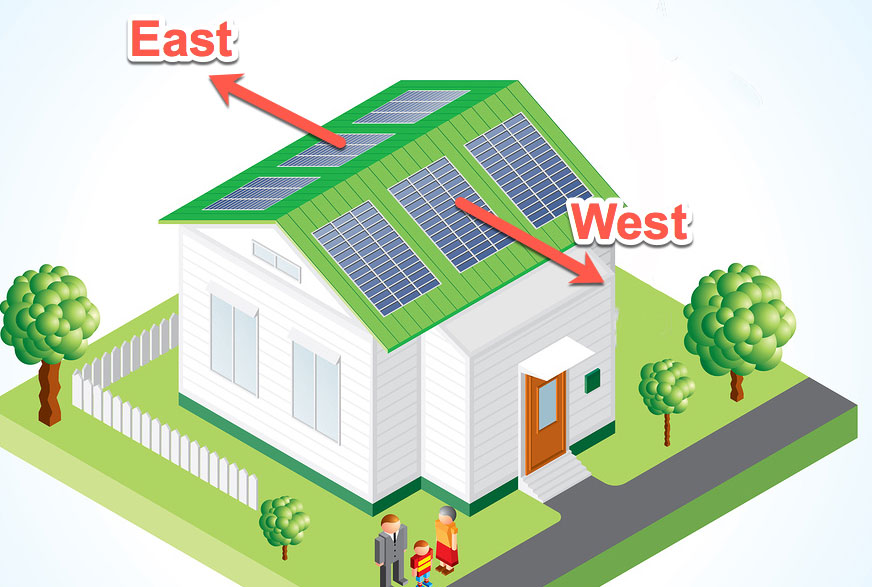
Is it OK to put East and West facing panels on a single input inverter?

Is it OK to put East and West facing panels on a single input inverter?
Imagine you walk in a shoe store and the shop assistant immediately starts measuring your head with a tape measure. You’d think she was mad, wouldn’t you? And you’d be right, of course. Sometimes the basics are just self-evident.
If you need shoes, all the information you need is right there at the bottom of your legs. Same with solar power. No reason to start anywhere but right up there on your roof.
And there are 3 questions about your roof that you have to answer right away before we move on to anything more advanced. And you’ll soon see why…
Today’s top solar tip:
Please don’t look to Kevin McCloud or Grand Designs for advice on solar power!
Now don’t get me wrong, I love Kevin McCloud, he seems like a top bloke. And Grand Designs is one of the few things I actually watch occasionally on the gogglebox.
But they really need to do their research when it comes to solar.
The UK episode on ABC1 last week showed that they don’t have a freaking clue about solar power. [Read more…]
Should you point your solar panels North so that you get the maximum power from them?
Not necessarily…let me explain:
And here’s the transcript if you prefer reading: [Read more…]
Here is (another!) really common question that I get:
“I’ve got 3 quotes for solar: The first company says my roof is at the wrong pitch and wants to charge me hundreds of dollars extra to put my solar panels on tilt frames to optimize the amount of electricity I get. The second mob say it is fine to just put the panels flush on my roof and the third guy says that, yes my roof isn’t at the perfect pitch, but the best solution is to mount them flush to the roof and simply add an extra solar panel to make up for any reduced power output.
Now I’m really confused! Help!”
The problem here is that there are 2 extremes of solar installer in my experience: [Read more…]
The following is a very common question that comes in to SQ HQ.
“My roofline is North/South, so my largest roof areas face either East or West. I have been told that North Facing is ideal, but I have a tiny North facing roof! Can I put some solar panels on the East or West Facing roof (or both) ?”
Short Answer: Stick some (perhaps all) on the West!
Longer Answer: In terms of the amount of power produced, facing your panels East will produce exactly the same amount of power as facing them West. In either case you’ll generally take a 10-15% power hit compared to having them facing the ideal direction (North).
So why do I say “probably West” as the short answer to the question?
Well, the reason I err on the West facing roof is because that part of your roof will get the sun later in the day. An East Facing solar array will generally produce its peak power at 10-11am. A West Facing array will produce its peak at closer to 2pm.
Most people use more energy later in the day. And most people want to use as much of their solar energy as possible, without exporting it. Why? Because at the time of writing most Feed In Tariffs give you less per kWh if you export the electricity than you pay for imported electricity. So most people will pay off their solar system quicker if they minimise exports.
Here is a photo I took of a house around the corner from me.
As you can see, it has solar panels on 2 separate roof areas. In solar jargon, you would say there are 2 “strings” of solar panels.
The main string is facing North, which is the best roof orientation for solar panels. These panels should get the optimum amount of sun throughout the day.
The smaller string is facing East. These panels will get 15-20% less sunlight than the panels facing North.
Obviously the installer could not fit all the panels on the North facing roof. Fair enough.
If your home will require solar panels on multiple roof areas, which face different directions, then you should use a special type of inverter to ensure that you still get good system performance. [Read more…]
Get up to 3 free solar quotes
✓ Solar ✓ Batteries ✓ EV Chargers
Before You Go..Download the first chapter of The Good Solar Guide, authored by SolarQuotes founder Finn Peacock, FREE! We respect your privacy and you can opt out from the newsletter at any time. |



Currently Raging Debates: